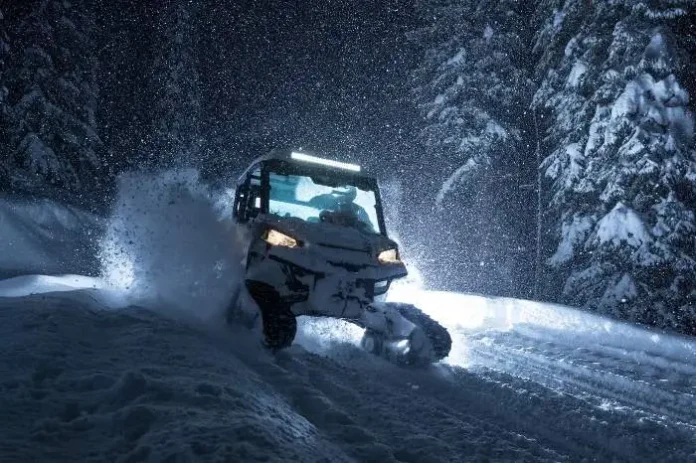When the sun sets and the trails go dark, your UTV’s lighting becomes more than just an accessory—it’s a safety system, a performance enhancer, and an essential part of the ride. Whether you’re racing dunes, tackling technical trails, or working at night, the right lighting setup transforms your experience from cautious to confident.
But choosing the right lumens—the measure of how bright your lights are—can be tricky. Too dim, and you’ll miss key terrain details. Too bright, and you risk glare, power drain, or wasted light. The goal is balance: the perfect amount of light output for your driving conditions.
What are Lumens and Why Should you Care?
Lumens measure how much visible light a source emits. The higher the lumens, the brighter the light. But when it comes to off-road lighting, brightness isn’t the only factor that matters. How that light is projected—its beam pattern and color temperature—determines how useful it actually is on the trail.
For most UTV riders, a setup that produces between 4,000 and 12,000 lumens per fixture offers ideal performance without overwhelming your vision or draining your battery.
Here’s what to keep in mind when evaluating lumens for your ride:
- More isn’t always better. Too much brightness can reflect off dust, sand, or fog, creating glare that reduces visibility.
- Beam focus matters. A well-engineered optic will project light exactly where you need it—down the trail, not into the sky.
- Color temperature affects clarity. White light (around 5000K) mimics daylight and helps your eyes process depth and contrast, while amber light cuts through dust and rain more effectively.
When choosing lights, look for a balance between brightness and control. You want illumination that extends your line of sight while maintaining detail close to your vehicle.
Spot, Flood, or Combo: What Works Best for You?
Your terrain and riding style determine which beam pattern fits best. Let’s break it down:
- Spot Beams: Focused, long-distance lighting that reaches far ahead. Ideal for high-speed runs across dunes, deserts, or open plains.
- Flood Beams: Wide-angle coverage that illuminates nearby terrain. Perfect for tight woods, rock crawling, and work areas.
- Combo Beams: The best of both worlds—long-range projection down the trail with wide coverage on the sides for all-around visibility.
Most riders find that layering different beam patterns gives them the best performance. For example, use spot beams on the roof to see far ahead and floods on your bumper to illuminate the immediate area around your UTV.
Another smart addition is underbody lighting. High-quality Can-Am rock lights are compact, durable, and built for tough environments. Mount them beneath your chassis or inside your wheel wells to illuminate your tires and ground contact points when maneuvering over rocks or through mud.
Rock lights not only enhance safety but also look incredible at night, giving your ride that professional-grade off-road glow.
Daily Use, Trail Riding, or Night Crawling?
The way you use your UTV should guide your lighting setup. A rider who commutes short distances at dusk has different needs than someone who spends hours on remote trails.
Also Read: The Most Scenic 12 Best Driving Roads in USA
Here’s how to match your setup to your riding style:
- Daily and Utility Use: For short rides, moderate-speed runs, or worksite use, a smaller lighting setup with 3,000–5,000 lumens per light is usually enough. Focus on flood or combo beams for close-to-mid-range coverage.
- Trail Riding: Trail enthusiasts benefit from a combination of spots and floods, totaling around 8,000–12,000 lumens. This setup ensures you can see obstacles early while keeping the sides of your path visible.
- Night Crawling: Rock lights, amber beams, and lower-mounted floods are your best friends here. You’ll want controlled lighting that enhances visibility without reflecting off dust or surfaces at close range.
Another consideration is mounting height. Lights placed too high can reflect off dust clouds and reduce visibility, while lights placed too low may limit reach. The sweet spot often depends on your terrain—roof lights for distance, bumper lights for depth, and rock lights for control.
Power management is also key. Make sure your battery and electrical system can handle your total wattage. LED systems are designed to maximize output while minimizing power draw, so you can run multiple lights without compromising reliability.
Finally, always consider local regulations. Some ultra-bright off-road lights aren’t street legal, so having a switch system that allows you to toggle between road and trail modes keeps your UTV compliant and flexible.
Also Read: All You Need to Know: Best US Cross Country Road Trip Tips
Durability, Control, and Baja Designs Quality
When you’re off-roading, your lighting setup faces more than just darkness—it faces dust, water, vibration, and heat. That’s why build quality matters just as much as brightness. Look for lights with sealed housings, waterproof ratings (IP67 or higher), and powder-coated hardware to withstand constant abuse.
Most UTV lights are engineered for long-term durability and precision. With advanced optics, replaceable lenses, and a lifetime warranty, you get lighting that performs consistently in the harshest conditions. Whether you’re tackling night trails in Kentucky or lighting up camp, reliability is non-negotiable.
Switch control also plays a big role in customization. With modern switch panels, you can manage multiple light zones independently—switch between fogs, floods, and rock lights with ease depending on terrain and speed.
Conclusion
Your UTV’s lighting setup isn’t just about style—it’s about safety, confidence, and performance. By understanding lumens, beam patterns, and mounting placement, you can design a system that gives you the perfect visibility for your adventures. With Baja Designs UTV lights, you’re not just lighting the path—you’re redefining what’s possible after dark.





